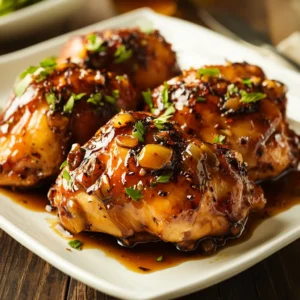Are you craving a hearty and flavorful dish that is both satisfying and easy to make? Look no further than this Slow Cooker Korean Chicken Stew! Inspired by traditional Korean flavors, this stew combines tender chicken thighs, savory gochujang, sesame oil, garlic, and a medley of vegetables to create a dish that’s rich in taste, comforting, and perfect for any season. Best of all, it’s made effortlessly in your slow cooker, allowing you to set it and forget it.
Korean cuisine is known for its bold, aromatic flavors, and this stew captures that essence beautifully. The combination of spicy, sweet, and savory notes in the broth creates a unique depth that is perfectly complemented by the tender chicken. Whether you’re making it for a cozy family dinner or a special gathering, this recipe is guaranteed to be a hit.
In this guide, we will walk you through the steps of preparing Slow Cooker Korean Chicken Stew, share some tips for customizing the recipe, and provide helpful information on the ingredients that make this dish so delicious.
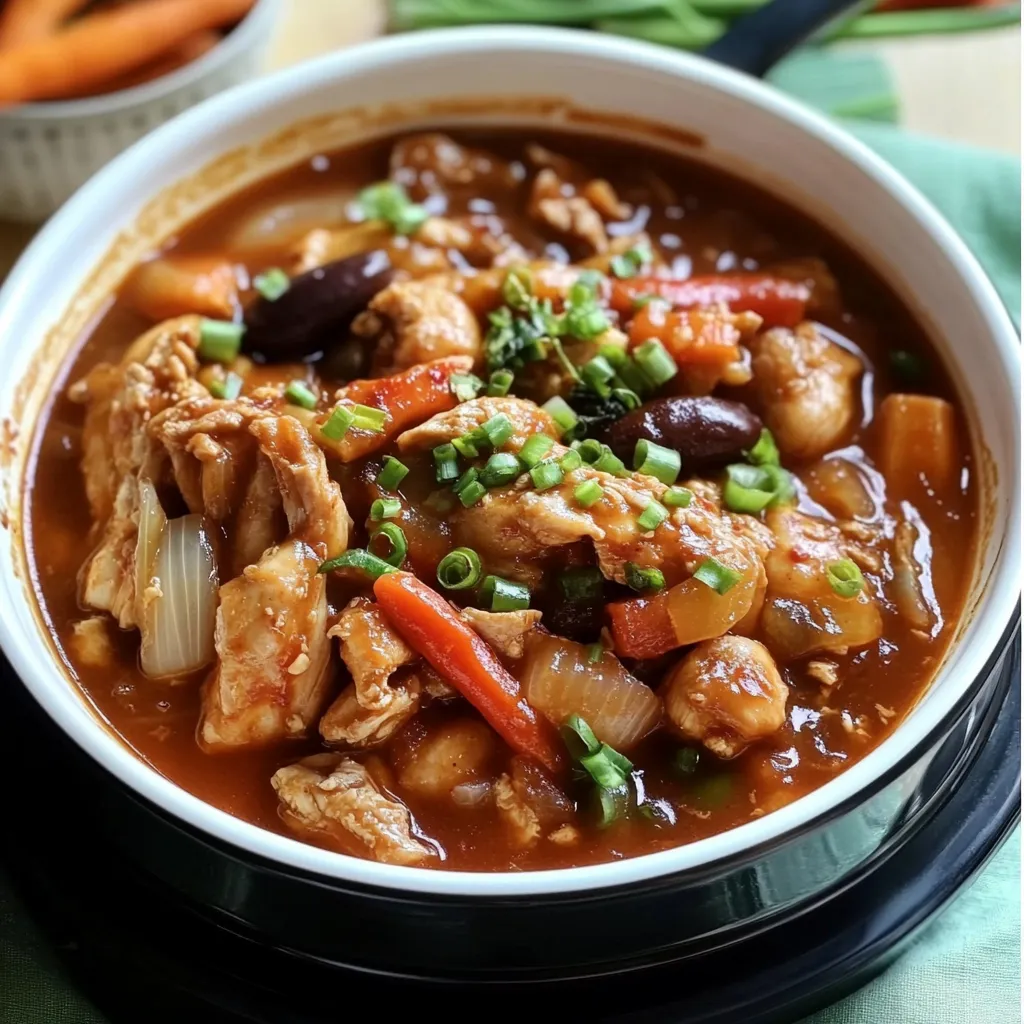
Ingredients Needed for Slow Cooker Korean Chicken Stew
The key to a great Slow Cooker Korean Chicken Stew lies in the ingredients you choose. Below is a list of the essentials, along with why each ingredient plays a crucial role in creating this mouthwatering dish:
Main Ingredients
-
Chicken Thighs: Chicken thighs are the perfect choice for slow cooking because they are naturally tender and juicy. They absorb the flavors of the broth while remaining moist, making them ideal for stews.
-
Carrots: Carrots add a natural sweetness and vibrant color to the dish. They also contribute essential nutrients, including beta-carotene, which is beneficial for eye health.
-
Mushrooms: Mushrooms bring a savory depth to the stew. Their umami flavor balances out the heat from the gochujang and enhances the overall richness of the dish.
-
Onion: Onions provide a savory base and a delicious aroma that enriches the flavor of the stew. They are essential for building the foundation of this hearty dish.
-
Garlic: Garlic is a must-have in any Korean dish, and it infuses the stew with its aromatic, bold flavor, elevating the overall taste.
-
Gochujang: The star ingredient of this stew, gochujang is a Korean fermented chili paste that adds spice, tang, and complexity to the broth. It’s a key element in bringing the stew’s signature flavor to life.
-
Brown Sugar: Brown sugar adds a touch of sweetness to balance the heat from the gochujang. It also contributes a glossy finish to the sauce.
-
Sesame Oil: Sesame oil imparts a warm, nutty aroma and a depth of flavor to the stew, enhancing its authenticity and richness.
-
Soy Sauce: Soy sauce is used to add saltiness and umami, further deepening the savory profile of the stew.
-
Stock: Stock serves as the flavorful liquid base for the stew. Chicken or vegetable stock works well, providing additional richness and depth to the stew.
-
Cornflour: This optional ingredient is used to thicken the stew towards the end of cooking, creating a smooth, luscious sauce.
-
Spring Onions: Chopped spring onions are used as a garnish, adding a burst of freshness and a mild onion flavor that balances out the richness of the stew.
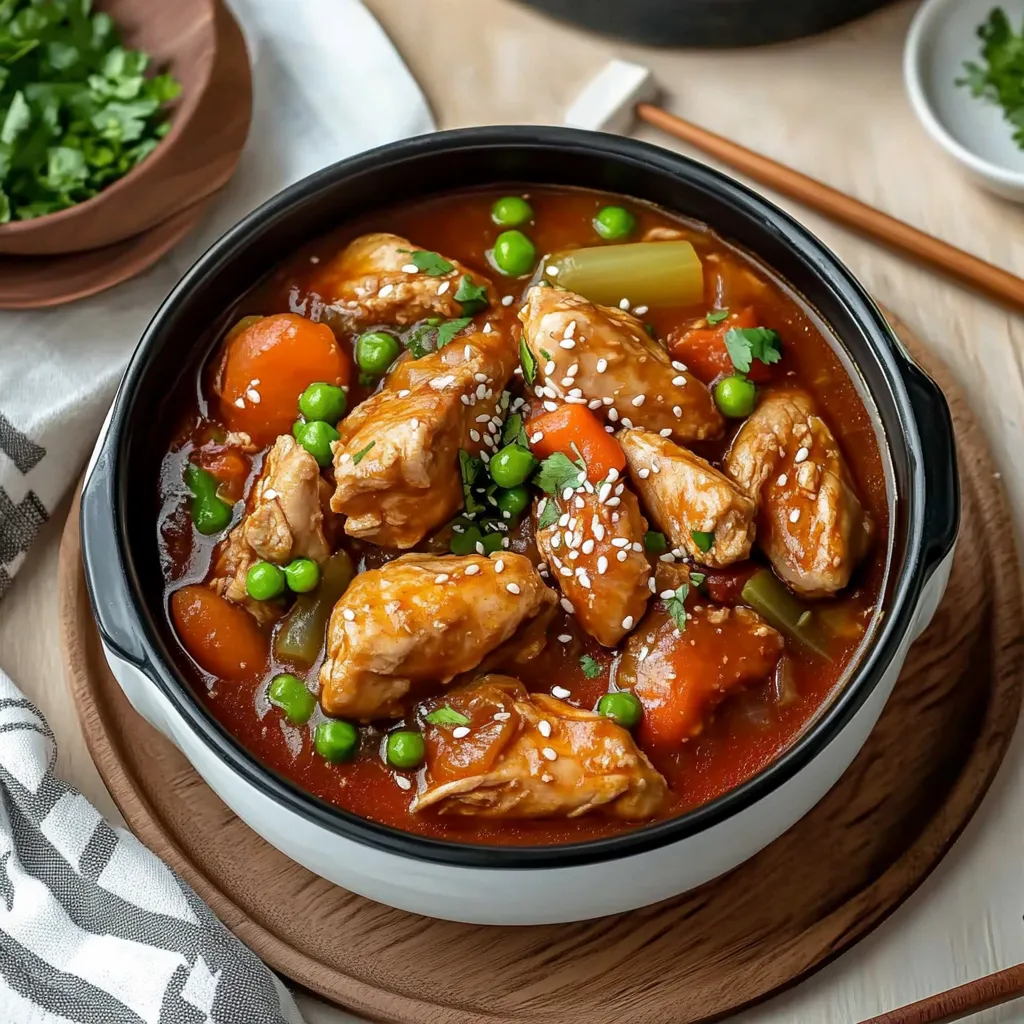
Optional Add-Ins and Variations
-
Pork: For a different twist, you can substitute chicken thighs with pork shoulder or pork loin. This gives the stew a different flavor profile while still maintaining the tender texture.
-
Extra Vegetables: Feel free to add other vegetables like zucchini or cabbage during the last hour of cooking to enhance the dish with additional textures and flavors.
-
Spicy Kick: Adjust the heat level by increasing the amount of gochujang or adding Korean chili flakes (gochugaru) for an extra layer of spice.
What is Gochujang?
If you’re new to Korean cooking, you may not be familiar with gochujang. This fermented chili paste is one of the most essential ingredients in Korean cuisine. It is made from red chili powder, glutinous rice, fermented soybeans, and salt, creating a thick, deep red paste that adds both heat and a hint of sweetness to any dish.
The fermentation process can take several months, resulting in a complex, savory, and slightly tangy flavor profile. Gochujang is often used in stews, soups, marinades, and dipping sauces. For the best results, it’s important to use authentic gochujang, which comes in a thick paste form (not the thinner bottled sauce). Authentic gochujang provides the right balance of spice, sweetness, and umami to bring your stew to life.
How to Make Slow Cooker Korean Chicken Stew
Now that you have your ingredients, let’s dive into the simple steps to make this flavorful stew in your slow cooker.
Step 1: Prepare the Ingredients
Start by chopping the vegetables and cutting the chicken thighs into bite-sized pieces. This helps everything cook evenly in the slow cooker.
Step 2: Combine the Ingredients in the Slow Cooker
Add all of your prepared ingredients, including chicken, carrots, mushrooms, onion, garlic, gochujang, soy sauce, sesame oil, brown sugar, and stock, to the slow cooker. Stir everything together to ensure the gochujang is well mixed with the other ingredients.
Step 3: Set the Slow Cooker
Cover the slow cooker with the lid and set it to cook on low for 4-5 hours or on high for 2-3 hours. During this time, the chicken will become tender, and all the flavors will meld together into a rich, savory stew.
Step 4: Thicken the Stew
If you want a thicker sauce, make a cornstarch slurry by mixing cornstarch with a couple of tablespoons of water. Stir the slurry into the stew during the last 30 minutes of cooking. This will give the sauce a velvety texture.
Step 5: Garnish and Serve
Once the stew is finished cooking, taste and adjust seasoning as needed with salt and pepper. Garnish with freshly chopped spring onions before serving. Enjoy your delicious Korean chicken stew with a side of steamed rice or vegetables.
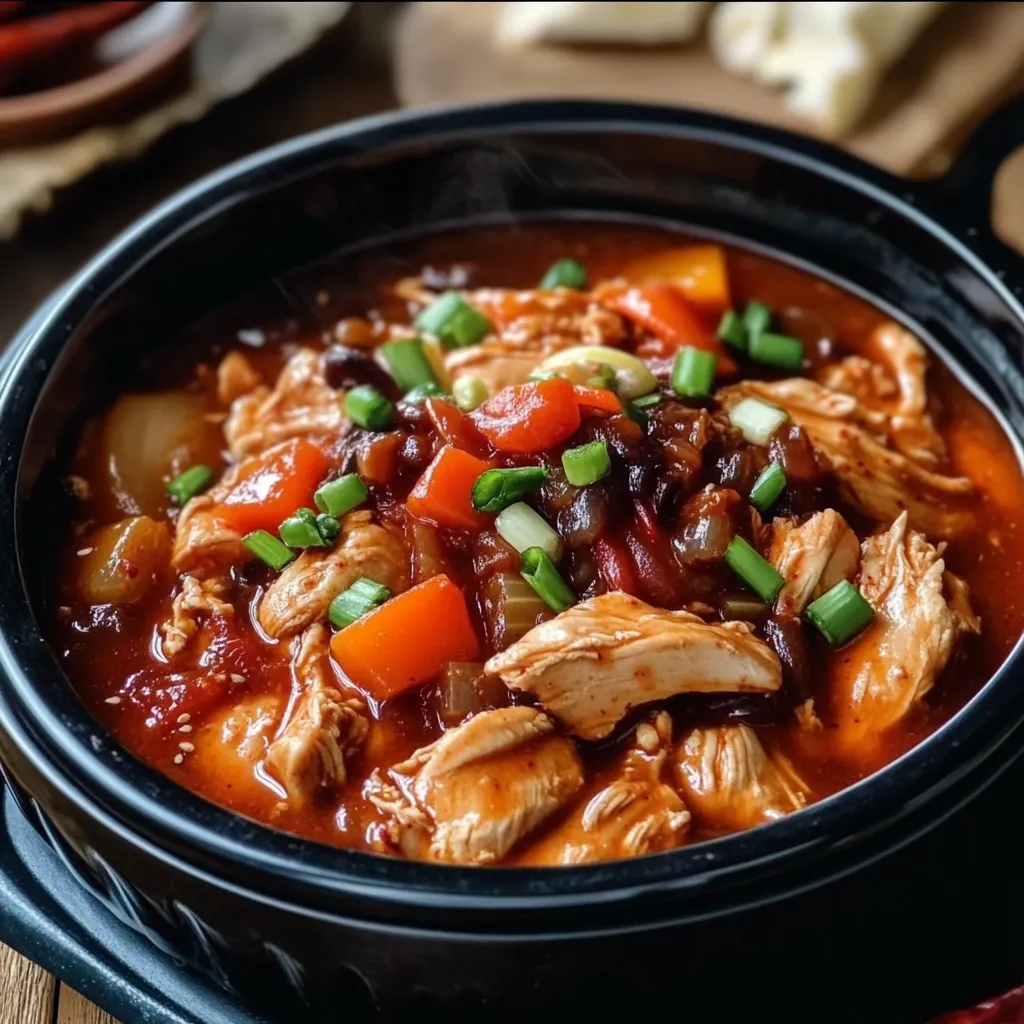
Converting to Oven Cooking
Don’t have a slow cooker? No problem! You can easily adapt this recipe for oven cooking. Here’s how:
-
Preheat the Oven: Preheat your oven to 160°C (320°F) for a fan-assisted oven or 180°C (350°F) for a conventional oven.
-
Prepare the Ingredients: Follow the same instructions for preparing the ingredients.
-
Layer the Ingredients: Layer the chicken and vegetables in a Dutch oven or lidded oven-proof pot.
-
Cover and Cook: Cover the pot tightly with a lid or aluminum foil and place it in the preheated oven.
-
Cooking Time: Cook for about 1 hour, checking the dish periodically. Add stock or water if necessary to keep the stew from drying out.
-
Check for Doneness: After 1 hour, check for doneness and cook for an additional 30 minutes if needed.
The result will be just as delicious and comforting as the slow cooker version!
Serving Suggestions
Pair your Slow Cooker Korean Chicken Stew with these sides for a complete meal:
• Sticky White Rice: The perfect side to soak up the flavorful broth and add texture to your meal. • Kimchi: A classic Korean side dish that adds a tangy and spicy kick to balance out the richness of the stew. • Pickled Vegetables: Serve with pickled radishes or cucumbers for a refreshing contrast. • Steamed Vegetables: Opt for healthy sides like bok choy or broccoli to add more greens to your plate.
Variations and Substitutes for Slow Cooker Korean Chicken Stew
While the Slow Cooker Korean Chicken Stew recipe we’ve shared is already flavorful and satisfying, it’s always fun to experiment with variations or substitutions to suit your tastes or dietary preferences. Here are some options to consider when customizing this dish:
Substituting Protein
-
Pork: If you’re a fan of pork, you can substitute chicken thighs with pork shoulder or pork loin. Pork shoulder, in particular, works well in slow cooking, becoming tender and juicy, much like chicken thighs.
-
Beef: For a richer flavor, try using beef short ribs or beef stew meat. Beef takes longer to cook but will absorb the flavors of the stew beautifully.
-
Vegetarian: For a vegetarian version, you can replace the chicken with tofu or tempeh. Just make sure to add the tofu or tempeh later in the cooking process to prevent it from breaking apart.
Vegetable Variations
-
Additional Vegetables: Feel free to add other vegetables to the stew to make it heartier. Zucchini or bok choy can be added toward the end of the cooking time to retain their texture. You could also add sweet potatoes or butternut squash for a touch of natural sweetness.
-
Greens: Add leafy greens like spinach, kale, or bok choy just before serving for extra nutrients and a burst of color.
Adjusting Spice Levels
-
Milder Version: If you prefer a milder stew, reduce the amount of gochujang and consider replacing it with a touch of sriracha or Korean chili flakes (gochugaru) for a gentler spice.
-
Extra Heat: If you like it hot, add more gochujang or a pinch of chili flakes to ramp up the spice level. You can even garnish with sliced jalapeños for added heat.
Sweetness Level
-
Brown Sugar Substitute: If you want a lower-calorie option, you can use brown sugar substitutes like stevia or monk fruit. However, keep in mind that these may alter the texture or glossiness of the sauce slightly.
-
Maple Syrup or Honey: For a more natural sweetener, you can substitute maple syrup or honey for brown sugar. These options will lend a slightly different but still delicious sweetness to the stew.
Thickening the Stew
-
Cornstarch: While cornstarch is used to thicken the stew in this recipe, you can also try arrowroot powder or potato starch if you prefer alternatives that are easier on the digestive system.
-
Flour Slurry: If you don’t have cornstarch, a flour slurry (mixing flour and water) can also be used to thicken the sauce. Use 1 tablespoon of flour mixed with 2 tablespoons of cold water.
How to Store Leftovers
If you have leftovers of this amazing stew, it’s easy to store them for later:
-
Refrigeration: Place the stew in an airtight container and store it in the refrigerator for up to 3-4 days.
-
Freezing: You can freeze the stew for up to 3 months. Just let it cool down before transferring it to a freezer-safe container. When you’re ready to enjoy it, thaw it in the refrigerator overnight and reheat it on the stove or in the microwave.
Reheating Tips
To reheat your leftover stew:
-
Stovetop: Place the stew in a pot over medium heat, stirring occasionally. Add a little water or broth if the stew has thickened too much during storage.
-
Microwave: Heat the stew in a microwave-safe container in 1-2 minute intervals, stirring between each interval until it’s heated through.
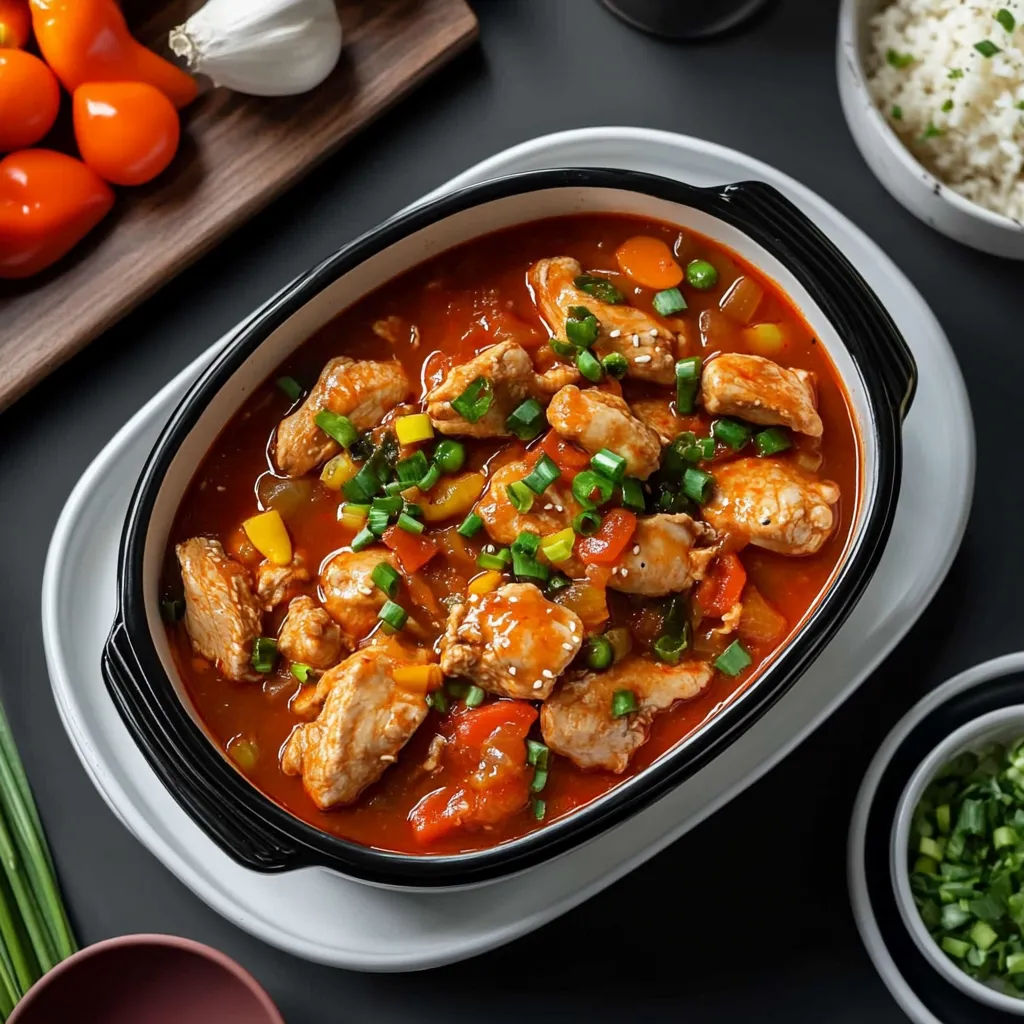
Recipe Card for Spicy Korean Chicken Stew
Ingredients:
-
750g boneless skinless chicken thighs (cut into bite-sized pieces)
-
1 onion, chopped
-
2 large carrots, chopped
-
150g mushrooms, halved
-
1 tablespoon minced garlic
-
2 tablespoons gochujang (Korean chili paste, add more for extra heat)
-
2 tablespoons soy sauce
-
1 tablespoon sesame oil
-
2 tablespoons brown sugar
-
2 cups (480ml) chicken stock (or vegetable stock for a lighter version)
-
1.5 tablespoons cornstarch (optional, for thickening)
-
Salt and black pepper to taste
-
4 spring onions (green part), chopped (for garnish)
Instructions:
-
In a slow cooker, add the chopped chicken thighs, onion, carrots, mushrooms, and garlic.
-
Stir in the gochujang, soy sauce, sesame oil, and brown sugar. Pour in the chicken stock and mix everything together until well combined.
-
Cover the slow cooker and cook on low for 4-5 hours or on high for 2-3 hours, until the chicken is tender and the vegetables are cooked through.
-
If you prefer a thicker stew, mix the cornstarch with 2 tablespoons of water to create a slurry. Stir the slurry into the stew about 30 minutes before it’s finished cooking.
-
Taste the stew and adjust seasoning with salt and black pepper.
-
Once done, garnish the stew with freshly chopped spring onions and serve.
Notes:
-
Gochujang is essential for the authentic flavor of this stew. If you can’t find gochujang, sriracha can be a substitute, but it won’t offer the same depth of flavor.
-
For a milder version, use less gochujang and omit the cornstarch for a thinner sauce.
-
You can add more vegetables like zucchini or bok choy in the last 30 minutes of cooking.
-
If you don’t have a slow cooker, you can also cook this stew in the oven or on the stovetop.
Nutritional Facts (Per Serving):
| Nutrient | Amount per Serving |
|---|---|
| Calories | 370 kcal |
| Total Fat | 13g |
| Saturated Fat | 3g |
| Cholesterol | 248mg |
| Sodium | 1119mg |
| Carbohydrates | 20g |
| Fiber | 2g |
| Sugar | 12g |
| Protein | 39g |
| Iron | 2mg |
Prep Time: 10 minutes
Cook Time: 4-5 hours (low) or 2-3 hours (high)
Total Time: 4 hours 10 minutes (low) or 3 hours 10 minutes (high)
Method: Slow Cooker
Cuisine: Korean
Servings: 4
Calories: 370 kcal
Yield: 4 servings



